PRODUCT
SOLUTIONS
- BY INDUSTRY
- B2B SaaS
- eCommerce
- E-learning
- Publishing
- BY BUSINESS SIZE
- Startup
- ScaleUp
- Enterprise
- BY BUSINESS MODEL
- Self-serve
- Sales-driven
CHARGEBEE RETENTION
A Definitive Guide to SaaS Pricing Models - Strategies, Examples, and Top Metrics to Track
As a growing SaaS business, if you’re not giving your pricing strategy a serious thought and often, you’re leaving money on the table. “#1 tip for pricing strategy is to treat it as an experiment.,” says Yoav Shapira, Director Of Engineering at Facebook. But how do you go about it?
In this guide, we will talk about various SaaS pricing strategies, different types of SaaS pricing models, and the metrics to track the performance of your pricing model.
What are SaaS Pricing Strategies?
Pricing strategies are methods used to determine the pricing of the product or service. Various moving parts contribute to pricing strategies, including competitors’ pricing, costs, and expenses. Let’s look at some of the popular pricing strategies.
Types of SaaS Pricing Strategies
Competitor based pricing
Just as the name suggests, the competitor-based pricing strategy depends on that of your competitors. This strategy only considers the publicly available information about your competitors’ pricing and does not consider factors like market demand or production costs. You can price your product higher, lower, or at par with the competition.
While this pricing strategy is fairly simple and may keep you afloat in a competitive market, it also means that you have minimal control over deciding and experimenting with pricing. This in turn can lead to missed revenue opportunities.
Penetration pricing strategy
Penetration pricing strategy is usually used by new entrants in the market. It involves pricing your product lowest as compared to competitors. This strategy can help gain a stronghold in a new and competitive market. A word of caution: low prices can cause losses, so this is not a long-term strategy.
Netflix is an excellent example of how a business can use the penetration pricing strategy. Netflix entered a market where DVD rentals were the norm. In 1999, Netflix started offering a subscription of 4 DVD rentals for $15.95. That’s less than $1 per DVD, whereas Blockbuster was charging $4.99 for a single DVD for a three-day rental period.
Penetration pricing allowed Netflix to establish a solid subscriber base, to begin with.

Cost-plus pricing
Cost-based or cost-plus pricing is one of the most straightforward pricing strategies. It works on the basic principle: to make profits, one must sell for more than you spent. This method is not research-heavy because it just involves adding your desired profit margin over your expenses.
Cost plus pricing = Customer Acquisition Cost (CAC) + COGS + Margin
Customer acquisition cost is the money spent to acquire each customer. COGS in SaaS is typically cloud infrastructure, engineering, and support.
For example, your customer acquisition cost is $100, and COGS per customer is $50, and the desired margin is 20%, your price comes to 150 + 30 = $180.
The cost-based pricing strategy is often applied when businesses have limited knowledge of the customer’s willingness to pay for your product. However, this strategy can prove highly inefficient in the long run as it does not consider the end consumer.
Value-based pricing
That brings us to the most suitable pricing strategy for SaaS businesses, the value-based pricing strategy. This strategy considers customers and how they perceive the value of the product or service. If you truly understand your customers and their needs, value-based pricing can help you package your products to meet those needs, even if your competitors are charging a higher price.
For example, check out how Crazyegg segments their pricing depending on the features available with each tier. This tiered pricing approach allows different customer segments to get value out of Crazyegg’s offerings depending on their needs and budgets and allows Crazyegg to upsell customers to a higher plan. It’s a win-win.
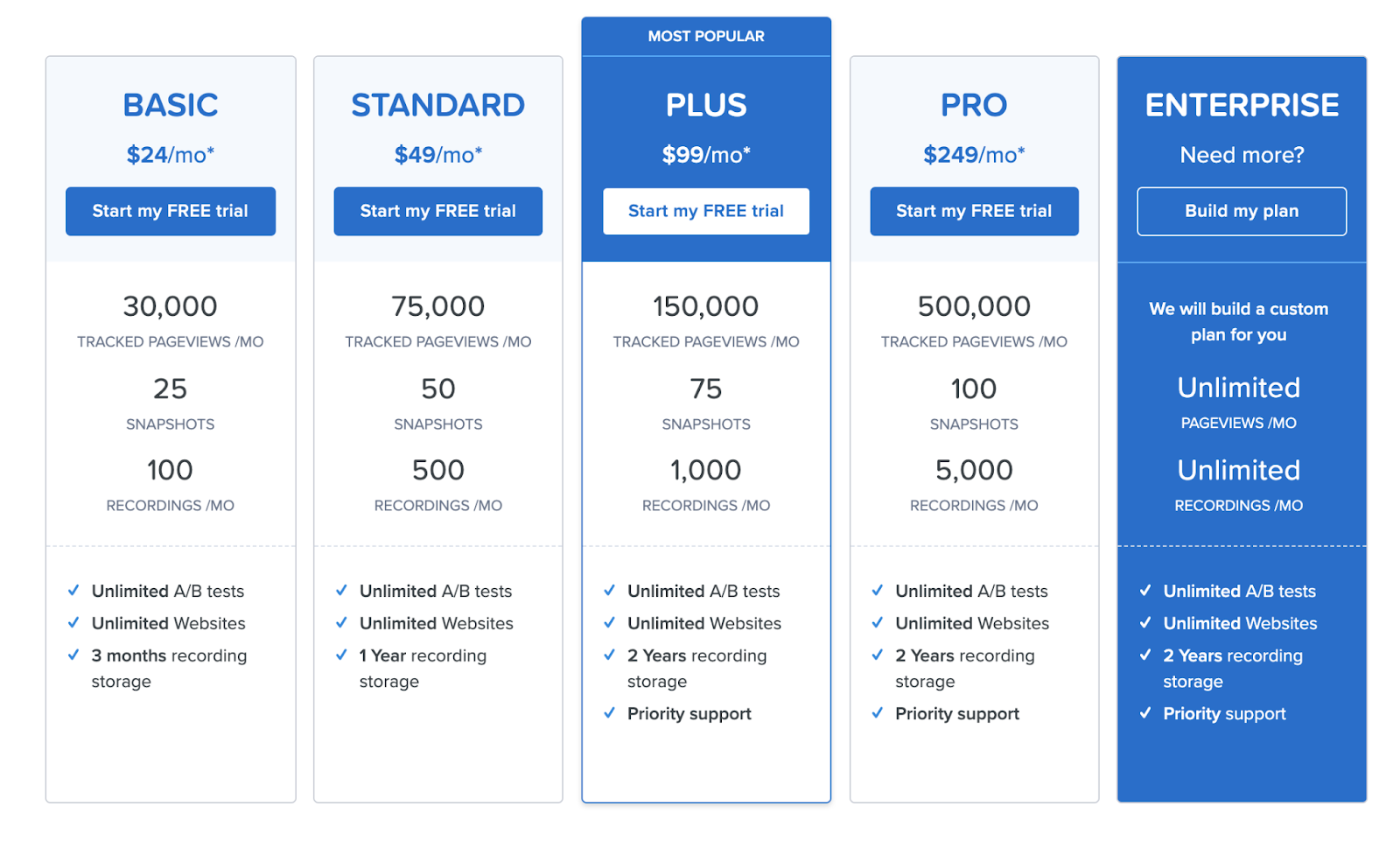
Provided you have deep insight into your consumer behavior, it is also possible to change and experiment with your pricing to suit different segments of your customer base.
Why is choosing the right pricing strategy important?
According to Gartner, SaaS businesses are the largest segment of the cloud market and are slated to grow exponentially in the coming years. And when it comes to SaaS, what many fail to understand is that your work doesn’t get over after building a great product. Building your product is just the first step.
Many SaaS companies spend all their blood and sweat building a great product and then throw it in the market, hoping to hear the sweet sound of “ka-ching” almost immediately.
But the secret sauce to building a successful product boils down to an essential factor - Pricing.
How to position your product?
How much value does it offer?
Who is your ideal customer?
Which pricing model complements your target market?
These are some of the most crucial questions that SaaS businesses should answer with complete clarity before deciding on a pricing model.
A great product coupled with a great pricing plan is a force to be reckoned with.
Pricing plays an integral role in helping you monetize your customers and keep your business in good health. It shouldn’t be overlooked and formulated with wishful thinking or weak statistical data.
So, how to choose the right pricing model for your product? Before answering that question, we must learn about the different types of SaaS Pricing strategies. Let’s discuss how you can choose a suitable pricing model for your business.
What are pricing models?
Pricing model is how you package the pricing of your product or service. It is how you determine what the best price for your product or service is. There are various ways to package your SaaS pricing, and each model has pros and cons. Let’s look at some of the SaaS pricing models along with examples in detail.
Types of SaaS Pricing Models
Flat-rate pricing model:
In flat-rate pricing, the product is offered with a set of features at a predetermined price. There are no pricing options or features to choose from. The method is based on the “one size fits all” pricing strategy, and you charge your customers the same amount monthly/annually regardless of how many users or their usage is.
Example: Basecamp is a real-time communication tool that helps teams stay on the same page. Their core value is simplicity. To synchronize with their values, they’ve incorporated flat-rate pricing for their product, which is thereby easier to understand and doesn’t confuse your customer by giving too many options.
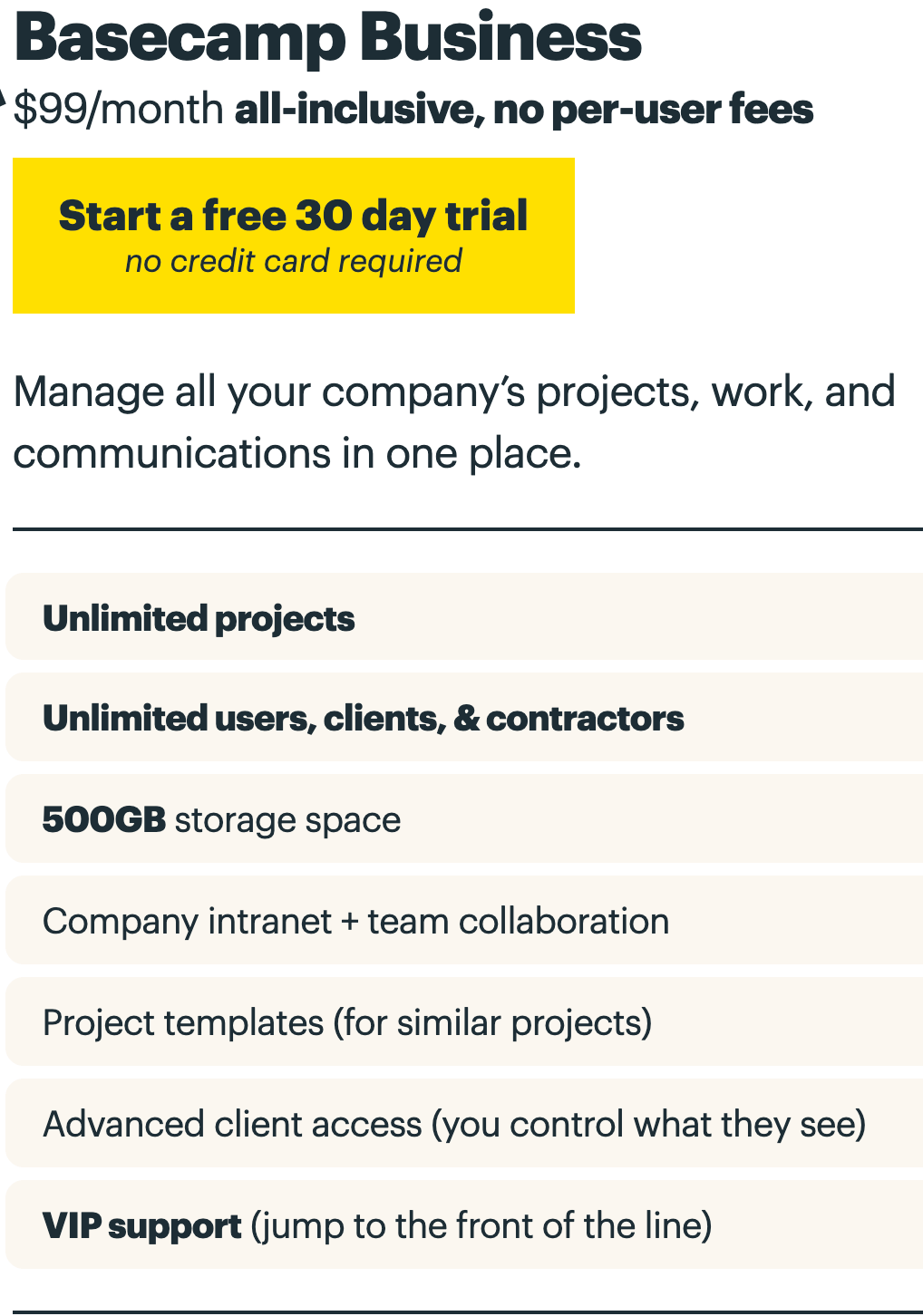
Advantages of flat-rate pricing:
Simple & easy to comprehend.
Forecasting revenue is far easier and accurate as there are no complications or varying price points to account for.
It helps you communicate and sell easily and focus your marketing and sales on a single, clearly-defined pricing offer.
For a new and lean SaaS Product, following the flat price model might help gain customers faster thanks to a simple pricing structure which might cut down the decision-making time.
Disadvantages of flat-rate pricing:
Ironically, the one size fits all strategy won’t work for all customers. Appealing to businesses that require custom plans is impossible, which discourages them from considering your product.
By incorporating flat-rate pricing, you don’t give your customers any choice, which might make them feel crippled when deciding to buy your product. Flat rate pricing might signal a “take it or leave it” approach denying that psychological satisfaction.
As there is no option to upgrade plans, you completely lose out on any upselling opportunities.
If you’re scaling, acquiring users from new markets will be difficult as your pricing is optimized for a specific niche market.
Tiered pricing model:
The tiered pricing model is based on the tiered pricing strategy for the real-world pricing scenario. Both terms are used interchangeably, leading to potential confusion. This post spells the difference between the two. In the tiered pricing model, different versions of the product are offered at varied prices. These can be based on features, a number of users, or usage and are decided by the business based on its product. Usually, 2 to 5 tiers are created, and your customers can choose from the same based on their needs. Using this pricing model, you can upsell to your customers incrementally, including features as they scale. The pricing tiers should be carefully constructed with an appropriate strategy failing which your customer will end up getting confused.
Example: Hubspot is a developer and marketer of software products used for inbound marketing and sales activities. They’ve priced their plans useful in such a way that new marketers to professional teams can use their product as they scale.
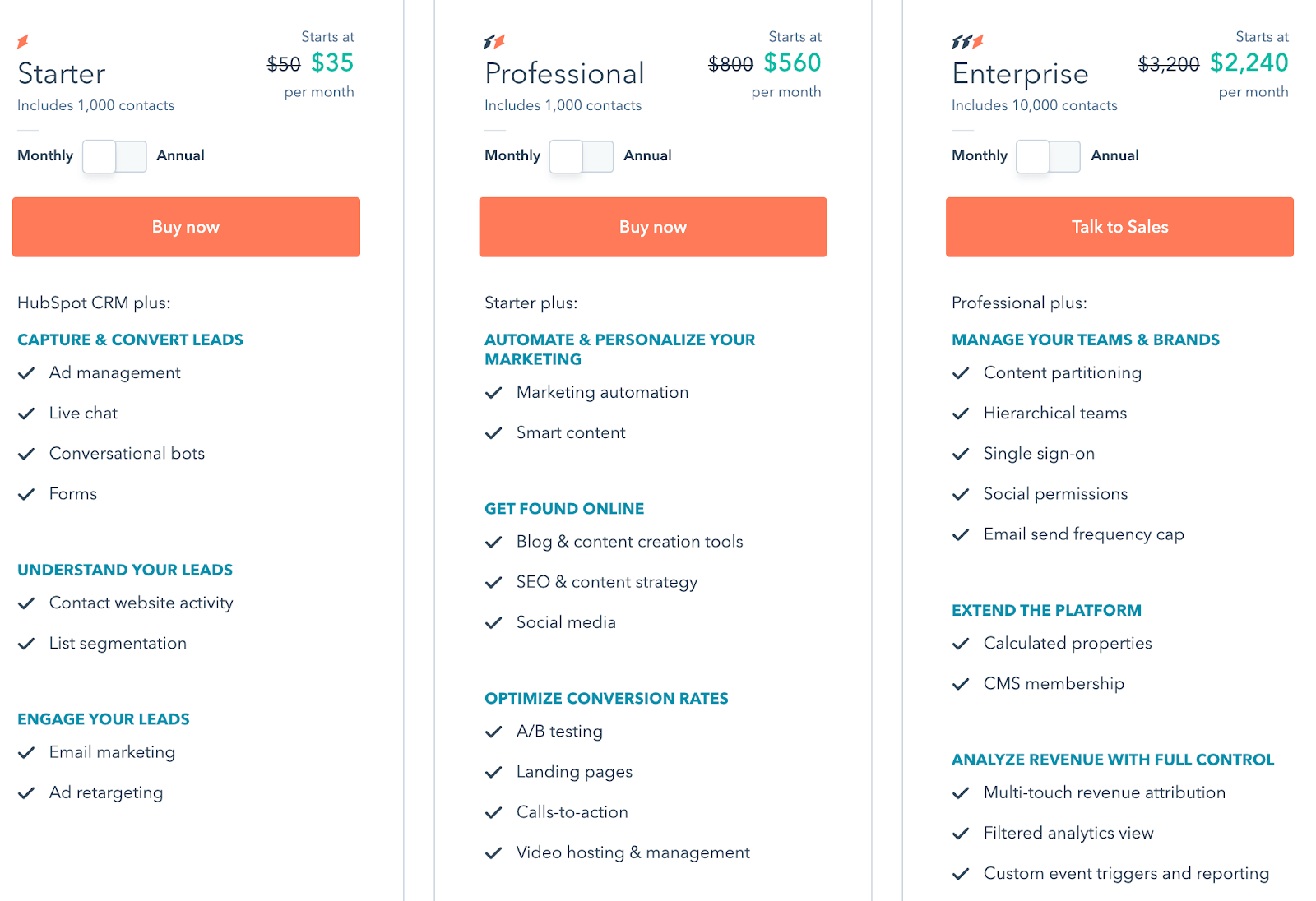
Advantages of tiered pricing model:
It appeals to different customers from beginners to advanced, thereby increasing your market share and revenue potential.
It gives your customers the power of choice so that they can pick and choose the plan that works for them.
Opportunity to upsell to your existing customers that’ll improve your existing MRR without any marketing spend.
Disadvantages of tiered pricing model:
The tiers should be carefully thought out and constructed based on the customers you’re targeting. Multiple tiers can be confusing, whereas fewer but poorly constructed tiers don’t help you reap the benefits of the tiered model.
Every tier increases the complexity of your customer’s decision-making process.
Usage-based pricing model:
The usage-based pricing model is also touted as the “pay as you go” model. In this pricing model, the customer is charged based on their usage of the product. If they use more, they’re charged more, and if they use less, they’re charged less. The usage can be charged based on various factors such as the number of Emails being sent, per API, per call, per transaction, etc. Some variants of usage-based SaaS models are purely usage-based, and some have a base subscription fee and then will be charged according to usage.
Example: Chargebee is a subscription billing platform that charges the customer by directly syncing the price charged for the pricing tier with revenue. If your revenue increases, you will be charged more. This ensures that customers can afford the product, and the price being paid is justified.
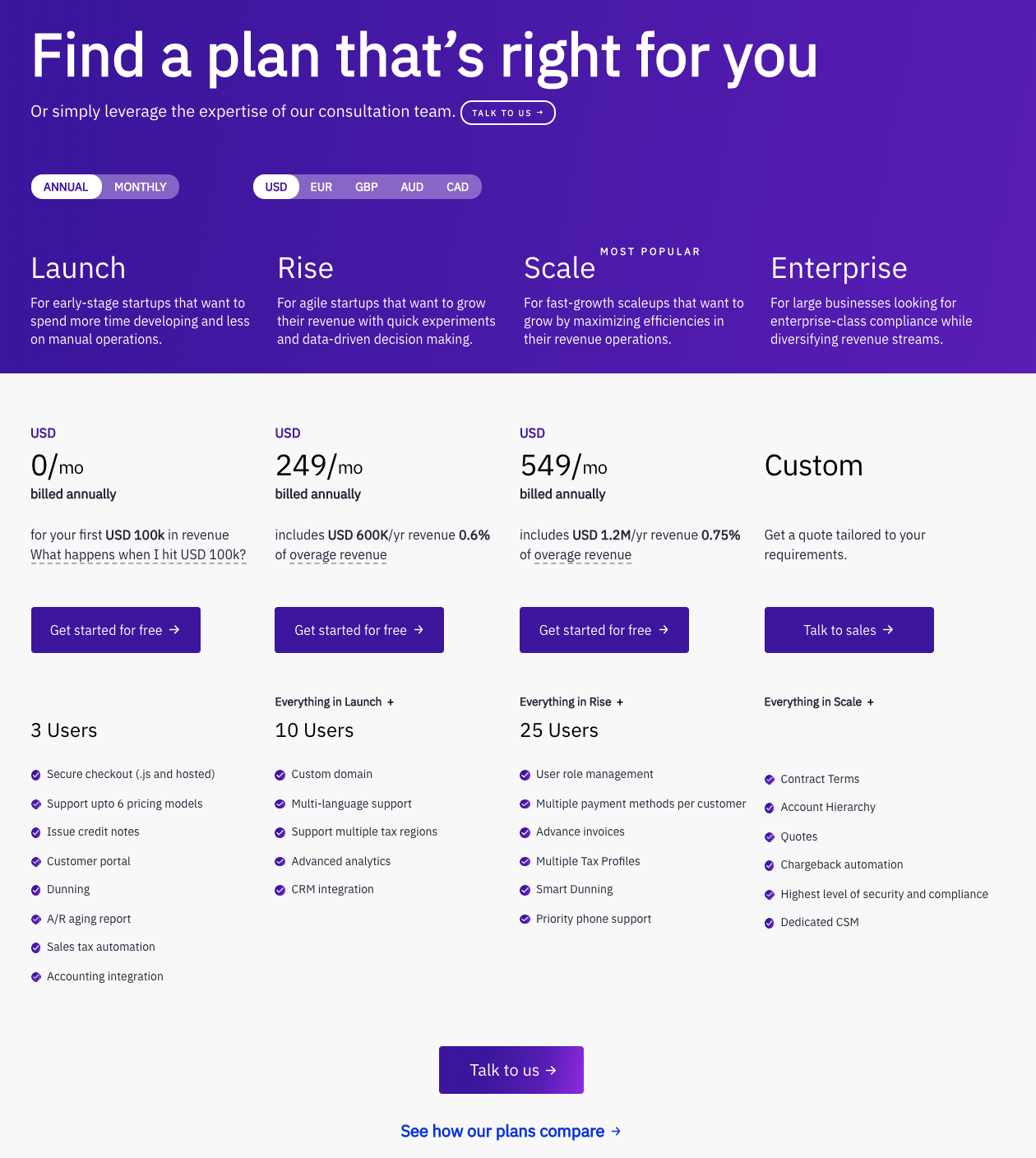
Advantages of usage-based pricing model:
Customers might often perceive this pricing model as fairest because it is directly proportional to their usage. If they use more, they’re charged more. It’s more transparent, and there are no hidden fees whatsoever.
The pricing is designed so that it is easily adaptable according to fluctuations in your customers’ business.
Disadvantages of usage-based pricing model:
Since you charge your users based on their usage, the value of your product doesn’t stand out and dims in comparison.
You cannot charge the customer based on their organization size, and you might lose revenue in the same process. For instance, you might end up charging your enterprise customers less because they use less, and a startup will be charged more if they use more. In this case, you might miss out on the revenue that your enterprise customers will generate.
Predicting revenue can be difficult as your revenue is based on your customer’s usage of your product, which cannot be measured accurately.
Per user-based pricing model:
Pretty self-explanatory, per user-based pricing model allows businesses to charge based on the number of individuals using the product. In this model, the revenue scales with the product’s adoption by the users in the company. Every account is charged, which makes it easier to predict revenue.
Example: Canva is an online graphic tool website with easy-to-use features and functionality that helps people create a multitude of engaging content. They charge their users on a per-user basis for using the product.
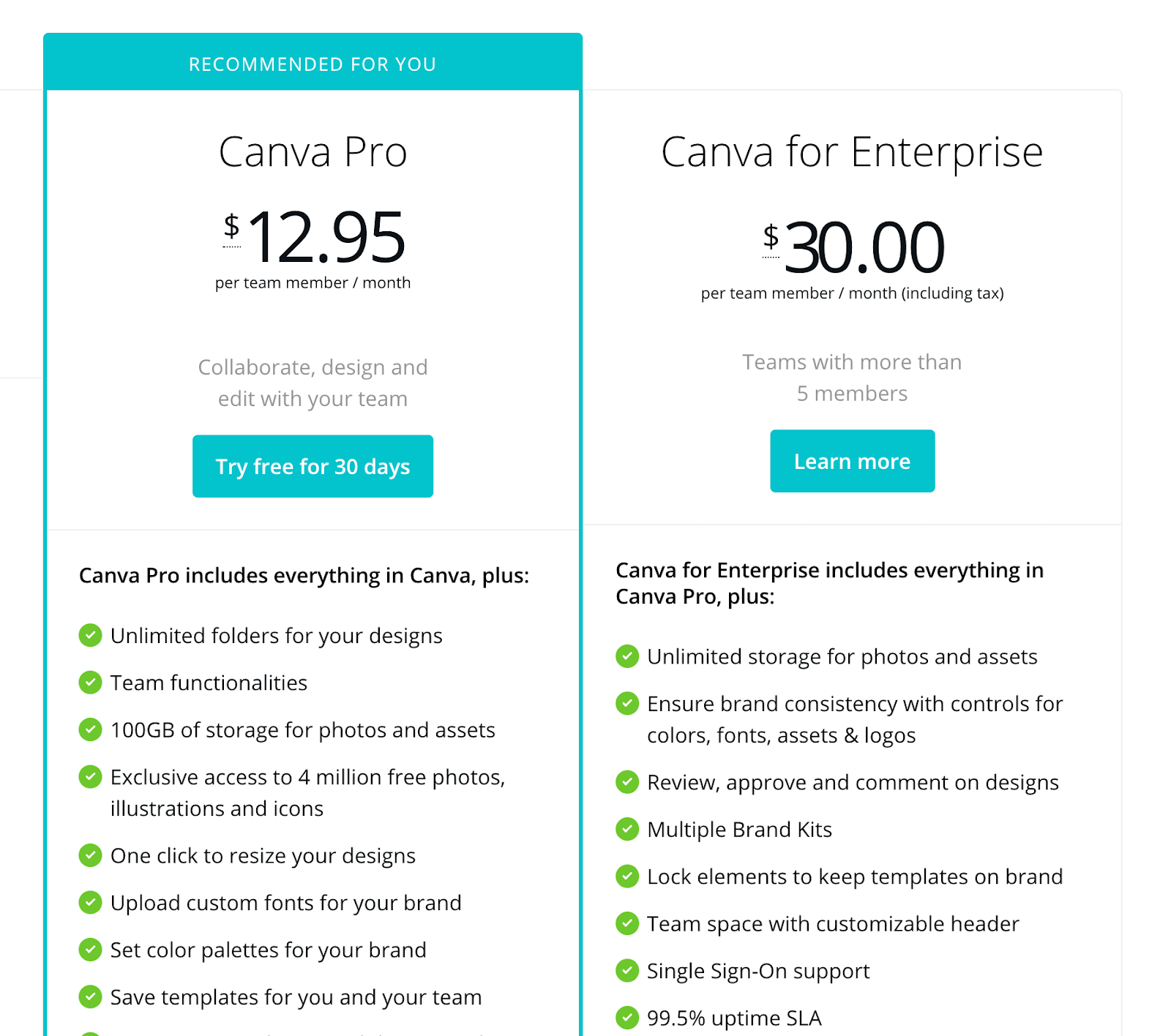
Advantages of per-user pricing model:
The per-user pricing model is easier to understand for your customers because it’s easier for them to calculate how much they’ll pay based on the headcount using the product.
All users are given complete access to the product with no shady upsells for more features.
This model helps people adopt your product quickly across the organization.
Disadvantages of per-user pricing model:
Sometimes, due to cost-cutting measures, the organizations may limit the number of users using the product.
Login abuse can become a trend - multiple individuals using a single account.
Pricing does not reflect the value of your product which might lead the users not to realize the same. This can hinder your brand growth in the long term.
Per feature pricing:
The product is priced based on the features and functionality which is offered to your customers. The more features, the more your customers pay and vice versa. The pricing tiers are separated based on the functionality available for each tier. In feature-based pricing, your customers scale along with the product as they expand. They might need new solutions to their problems during growth and hence upgrade to the next level. As per the feature pricing model, you’re tying the price directly to the value offered by you to your customers.
Example: QuickBooks is a small business book-keeping software that helps manage and account for sales and transactions. They price their product based on the functionality. For instance, their starter plan enables you to track income, expenses, sales, sales tax, and so on. As you upgrade, you can manage bills, users, and track the time taken, and so on. The rates they charge increase incrementally with the features they offer in each tier.
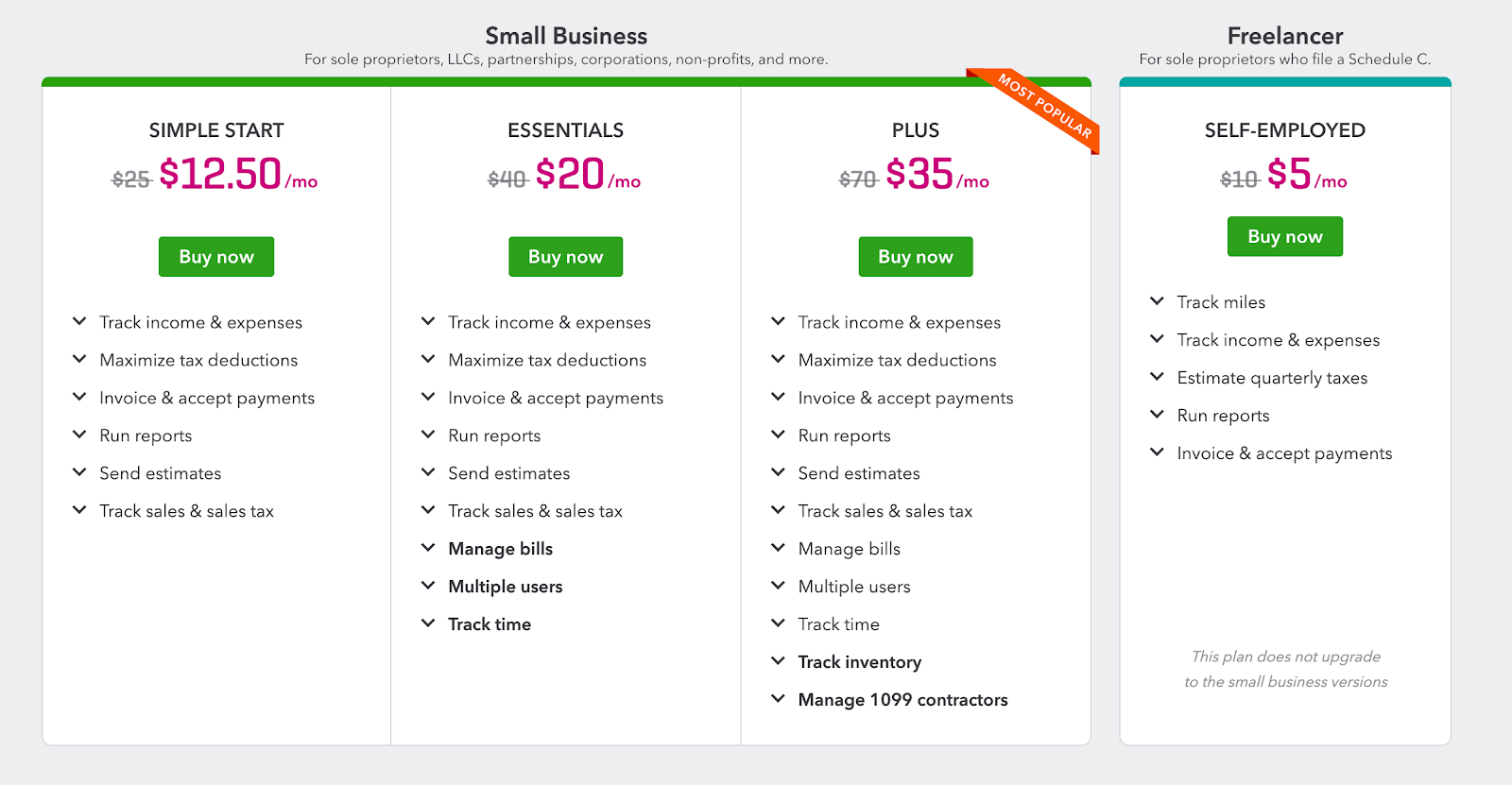
Advantages of per feature pricing model:
Allows your customers to pay only for what they need and what is in their functional scope.
It saves money as they need not pay for unnecessary features that might not be useful for them at their current growth stage.
Disadvantages of per feature pricing model:
It is difficult to get it right because it's impossible to tell which customer needs which features.
The customer might not welcome some add-on features as they might not find its usage and restrict themselves from purchasing upgraded versions.
Freemium pricing model
Freemium is a widely adopted pricing model which allows businesses to lure users to signup for a free but limited version of your product. The idea is to hook users to your product and nudge them later to upgrade for the paid version. In Freemium, certain features are offered for free, and a paid upgrade is available when they want to access more functionality the product has to offer. In the Freemium model, you usually keep your potential customers in the free product incubator and target sales and marketing campaigns exclusively for them so that they can upgrade.
Example: Drift, a conversational marketing and sales technology company, offers its solutions in a free trial version, thereby letting their freemium versions act as a lead-generation tool.
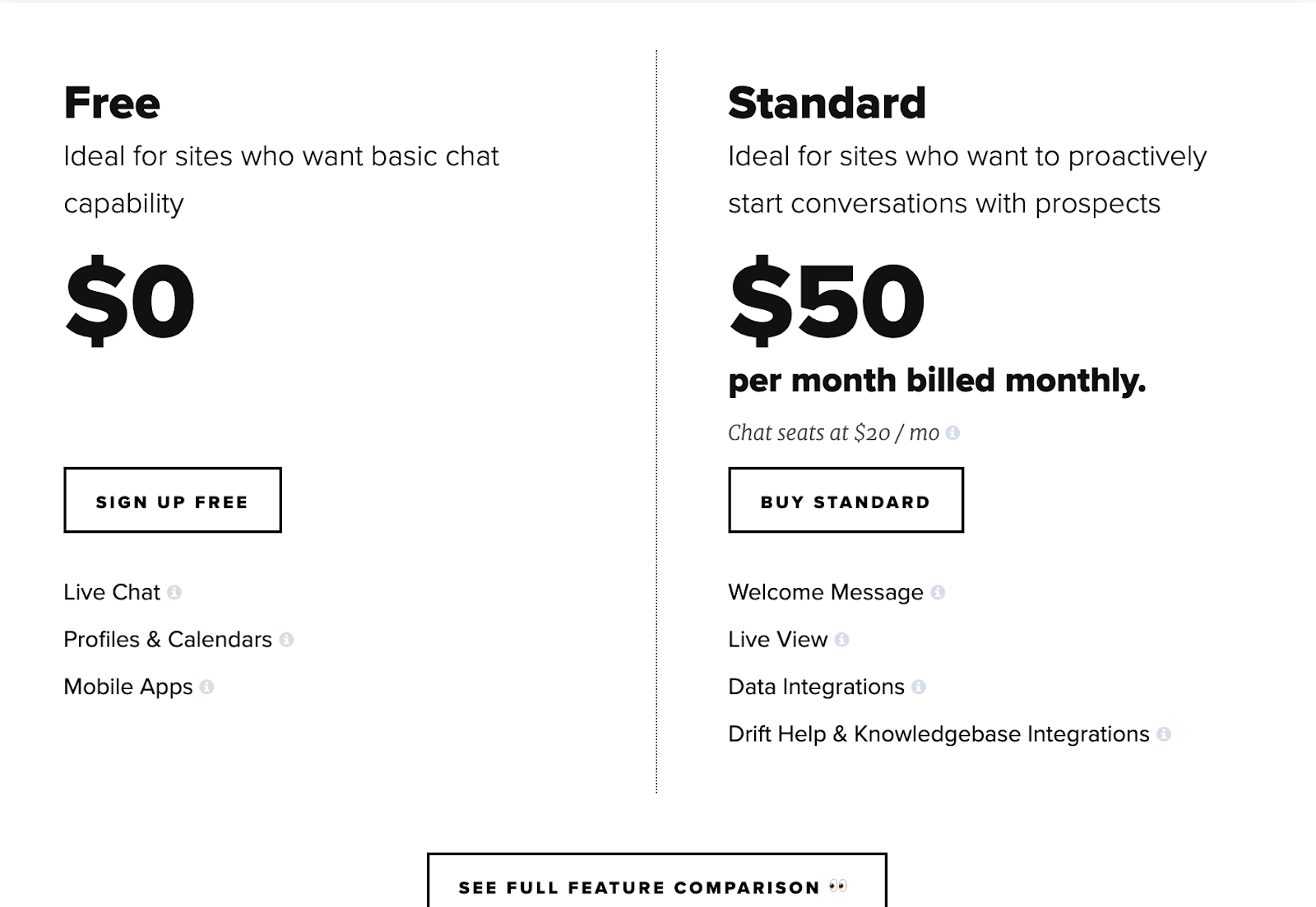
Advantages of Freemium model:
Low Customer Acquisition Cost (CAC) as the product drives adoption faster and cheaper than other models.
Monetize free plan by introducing ads alongside nudging users to upgrade to a paid plan.
It acts as a front door that lets your customers by allowing them to try out the product for free.
The free version is an ideal testing ground to experiment with new features without upsetting your revenue-generating engine.
Disadvantages of Freemium model:
Statistically speaking, less than 10% of free users convert into paying customers. There’s always the unnecessary burden on your limited resources used to serve free users more than your paid customers.
It decreases the value of the product in the eyes of the customer. When someone pays for a product, the way they see the product is entirely different, and they might not abandon using the product on a whim, which doesn’t apply to Freemium models.
It’s an increased burden on your operational resources mainly caused by free users.
Per active user pricing model:
In a per active user pricing model, you charge your subscribers only based on how active they’re. In other words, you only charge the users who use the product. Teams can enroll as many users as possible to buy the product, but they will be charged only based on those who use them. This means that no money is spent on vacant places.
Example: Slack, is a cloud-based instant messaging platform, that enables people in the organization to collaborate effectively. They’re famous for using this pricing model, as they charge their users based on how many people actively use the product.
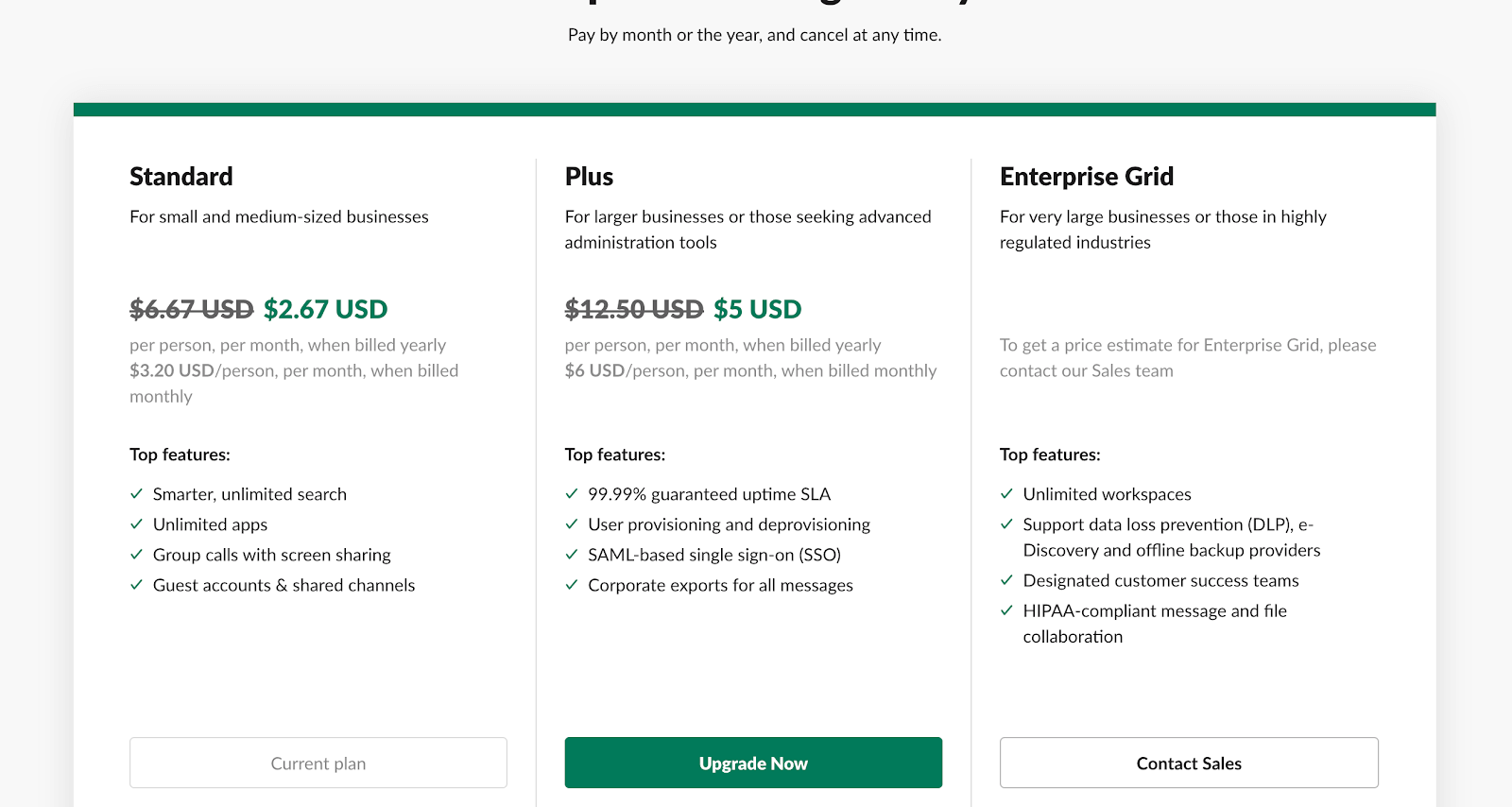
Advantages of per active user pricing model:
No money is wasted on inactive users; only the active ones have to pay.
Enterprise customers can buy the product for their teams, and they will be charged based on the people using the product, thereby reducing the risk of adoption across the organization.
Disadvantages of per active user pricing model:
Doesn’t work well with small business because they’ve small teams and everyone will find application in the product.
Some customers might not use the product at all even though they have access.
Multiple logins through one account to reduce costs can take a toll on your revenue health.
Given so many options of pricing models, you might get confused as to which one is the best suited for your business. But, pricing models shouldn’t belong by choosing based on what your competitors have done or what articles you read to find the best pricing model. A pricing model is unique to every business; whatever competitor data or guides you get online should only be your knowledge base giving you a small level of hindsight.
How to choose the right pricing model for your SaaS business?
To choose a pricing model, you’re supposed to think from your customer’s shoes and base your decision on the data generated. Below are some points that will help you set the stage before choosing a pricing model:
Know your LTV/CAC ratio when choosing a pricing model. It helps to determine if the model is going to keep your business in good health.
Pricing isn’t a single department decision. It’s a decision which should be jointly made by Marketing, Sales, Product, and Management. They help you position, pack, manage and target your audience effectively.
Develop buyer personas from the data available. Do thorough research on who your customers are and which segment of the people you’re speaking with. This will help you position your product more effectively, based on what they need.
Come up with differentiated tiers after having a clear idea of your buyer personas. Knowing how to differentiate what a startup will want from an enterprise will help you pack and sell your features at different price points, helping you sell effectively.
Arrive at your pricing model from data inputs by your existing customers and prospective customers. Learn to ask what they want from your product because your customers are the people using the product. What is a better way than to ask them what they want rather than making random guesses, which might end up going downhill?
How to implement pricing changes with low-code?
Choosing a pricing model for your business can be a complex task. But after you’ve picked one, you can hardly put your feet up and relax. Experimenting with pricing can be a critical lever to the growth of your business. This doesn’t mean changing your revenue models willy-nilly. It’s about understanding how your customers use your product, what they’re willing to pay for and how you can package that value proposition most efficiently. To do this competently on a large scale, you require an experimentation engine with fine-grained access control over your products’ offerings that allows you to monitor the impacts of your changes.
When you have control over changing what a customer is entitled to in your product - like feature limits, integrations, or other benefits - without having to depend on developer hours to code it, this changes the way you can implement and run pricing experiments. You can launch pricing changes faster, and provide value to your customers.
A good entitlements management system enables you to have fine-grained access to revoke or provide feature access on a customer level or subscription level. It makes monetization easy - like making changes to pricing, bundling and unbundling plans and addons, etc.
With entitlements, you can
1. Incentivize upgrades by giving a customer features beyond their plan
When a user is offered to try out features from a higher plan, the user gets to experience the value it provides, and is naturally primed to upgrade.
2. Optimize limits and benefits of each subscription plan by running experiments
Iterate and experiment with your plan offerings to find the optimal packages for your target segments.
3. Track feature usage to understand which key features drive value and revenue for your customers
Understand how your customers use your features, which features are most valuable to them, and monetize your product efficiently.
As SaaS businesses steer towards value-based pricing, entitlements become a powerful tool for any organization looking to discover its value levers and boost its growth trajectory.
How to track & analyze your Pricing model?
The work doesn’t end for you after deciding on a pricing model. To find out the profitability and usability, you need metrics to track and analyze how well your customers are receiving your pricing model. Here are the methods on how to analyze your pricing model:
LTV/CAC ratio:
While creating your pricing model, it is essential to look at the LTV (lifetime value) and CAC (customer acquisition costs) ratios.
Why? This ratio helps you arrive at a profitable business model. The ratio between these two parameters should always be greater than one so that you don’t lose money on every customer you get. A lower LTV/CAC ratio shows how long it takes for your customer to payback, resulting in a potential loss for your business. Many companies ignore the importance of the ratio and step into the zone of losing money in their business with every new customer.
Gross MRR churn ratio:
Gross MRR churn is the percentage of revenue lost due to the cancellation of the license for the product or due to downgrades. It estimates the total loss to the company in terms of percentage. It is calculated by dividing total MRR churn (for the month) and total MRR (for the month) and multiplying the resultant answer by 100 to obtain the percentage.
Gross MRR churn = total MRR churn/ total MRR x 100
The ideal Gross MRR churn should be around 1% for enterprise companies and small businesses around 2-2.5%. If your gross MRR churn ratio is greater than 5%, it means that you’re losing a substantial part of revenue due to cancellation and downgrades.
Expansion MRR:
Expansion MRR is the ratio that tells us about the revenue generated through add-ons, upsells, and cross-sells. It is given in terms of percentage. It shows if you can deliver and add more value to your customer to monetize the value. It is calculated by subtracting the total expansion MRR at the beginning of the month from the total expansion at the end of the month, divided by the total MRR at the beginning of the month, and multiplying the resultant by 100.
Expansion MRR = Total expansion MRR at the end of the month-total expansion MRR at the beginning of the month/total expansion MRR at the beginning of the month x 100
Total expansion MRR shows how already existing customers generate more revenue and value to your product, thereby generating more demand. An increased MRR ratio shows sustainable growth since it reduces the new CAC cost but at the same time generates increased revenue and leading to good business health.
Upgrade MRR:
Upgrade MRR is similar to expansion MRR, but it primarily concentrates on upgrades and applies to subscription-based businesses. When a customer upgrades from one of the existing plans to a higher plan for more functionality and features, it is called the upgrade MRR. It is calculated by subtracting the cost of the higher plan from the cost of the existing plan.
Upgrade MRR = Cost of the upgraded/higher plan - Cost of the existing/lower plan
Upgrade MRR shows how many customers are upgrading to a higher plan to opt for advanced functionalities. Adding new features to the product, you encourage your customers to upgrade. If this value doesn’t increase, it shows that you’re offering high value for a low price, thereby helping you reassess your pricing strategy.
Conclusion
Taking all the information and going back and forth questioning your pricing strategies and plans is the right way to begin with before arriving at a model. Here are a few key takeaways:
Pricing isn’t something you set one time and forget. It should be revised as the product ages.
Pricing should scale along with your product and should convey the value of your product.
Your plans should resonate synchronously with how your product is packaged and based on your buyers.
Implementing pricing changes shouldn’t take weeks - it should take minutes.
This information will help you gain insight into the pricing world and arrive at the best pricing strategy and plan for your business.